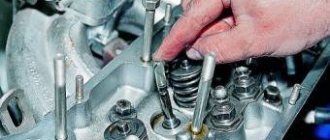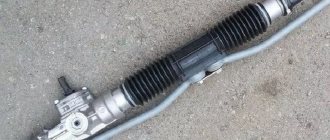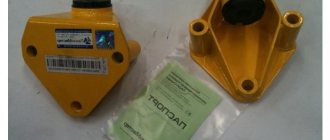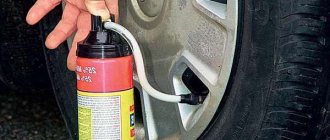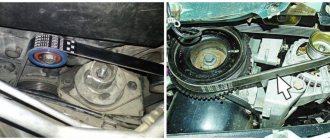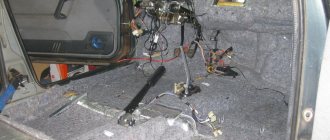No one is immune from car breakdowns on the road. But if some of the breakdowns can be fixed on their own, for example, by replacing a wheel, in other cases the car driver panics and does not know what to do.
So, on our roads you can puncture the tank of your car and in this case it is likely that you will not hit the target. Think about what you can do in this case, how to repair the gas tank yourself, so as not to resort to the help of a tug, especially since this problem can overtake you where technical assistance can be a serious problem. a big problem.
DIY gas tank repair
The first method is used if the puncture of the tank is quite extensive, and the design of the tank itself allows such repairs. In this case, the puncture can be tightened with a standard bolt on the nut, onto which a rubber pad is placed.
This is done as follows: widen the hole to the size of the bolt, put a washer on the bolt and insert the previously cut rubber gasket. We insert the bolt through the neck of the tank into the prepared hole and screw it in, and only then put on the gasket, washer and screw the nut on the outside of the bolt.
Of course, the best option is to use gas-resistant rubber, but a tube from a truck will suffice. It is not necessary to use wet rubber, which will quickly dissolve in gasoline and you will have to rebuild the fuel tank. Returning home, you can put it all in decent shape, that is, counterattack, remove excess threads and paint the repair area.
This method of repairing gas tanks is widely used by truck drivers who know a lot about car repairs. Moreover, such repairs will allow you to use the gas tank for many years, because there will definitely be no damage to the gas tank at the workplace.
Second way. If the hole in the gas tank is not too large, it can be sealed with ordinary Moment glue. The only thing you need to remember is that the glue must be domestically produced; Western models will not cope with such a task. We soak a piece of fabric with glue and place it on the hole.
Since the glue takes a long time to dry, and there is no time to wait, after applying a napkin to the hole, we spray nitro paint, which should be in the car repair kit. This is enough to get to the gas station.
Third way. If our car has a carburetor engine, i.e. one that has a diaphragm fuel pump, then if the gas tank fails, you can, in principle, not make any repairs, but just take a plastic bottle with a larger capacity and pour gasoline into it. , and then disconnect the flexible hose from the gas tank. fuel pump that goes to the fuel tank, and place it in the prepared plastic container.
It would be nice to secure the cylinder near the radiator and you can safely go to a car service center. If there is no cylinder, you can use the washer reservoir for this purpose.
Material and characteristics of the metal tank
We will be considering a container made of metal, because as mentioned above, such a gas tank can be repaired. As for the material from which this container is made, in 95% of cases it is a soft steel sheet. This sheet has additional treatment, usually a secondary lead coating, which slows down irreversible corrosion processes.
The advantage of this material and the reason why it can be repaired is that when deformed, it is possible to level the metal sheet. If for any reason a gap appears in such a gas tank (for example, a breakthrough due to an accident or thinning of the material due to rust), then it can be soldered or welded.
Cold welding gas tank repair
Cold welding is a good way to repair a damaged gas tank.
Seal the hole in the tank with epoxy in this way: first clean the repair area, mix the epoxy resin with the hardener, heat it if necessary, apply it to the engine so that the glue warms up, mix again, take a suitable rag, moisten it well with glue and attach it to the hole in the fuel tank .
And in this case, it will save you from the hassle of breaking the tank for a while, and if you have done high-quality cold welding, you won’t even be able to ask for help at the gas station.
A machine breakdown can occur right on the spot. If you notice that your car's fuel tank is leaking, the problem will need to be partially corrected on site. This way, you can drive to a service station or workshop, where the problem can be completely fixed. How? The answer is below.
- General safety rules
- Plastic gas cylinder Cold welding Adhesive (sealants) Hot soldering gun
- Cold welding
- Adhesives (sealants)
- Hot soldering gun
- Metal Gas Cylinder Cold Welding
- Cold welding repair
- How to solder a gas tank
- Alternative Tank Repair Methods
- Cold welding
- Adhesives (sealants)
- Hot soldering iron
- Cold welding repair
- How to weld a gas tank
General safety rules
If your car's fuel tank starts leaking and you decide to repair it yourself, you must follow these rules:
- Before starting repairs, drain all fuel (put the car on a jack and drain gasoline through the pipes);
- Dry the fuel tank thoroughly;
- If necessary, disassemble the tank (it all depends on where the hole was made);
- Check the entire tank to see if there are any holes anywhere.
Plastic gas tank
Most often, in plastic gas cylinders, longitudinal cracks occur in the cylinder body or at the place where the cylinder halves are welded. There are several ways to fix such a tank.
Cold welding
Whether it will be possible to repair a fuel tank using cold welding depends on what material the tank itself is made of. If soft plastic is used, it will be more effective to seal the hole, since the cold weld will not "lay" due to poor adhesion of the plastic. If the plastic is hard, you can safely buy cold welding. Use it according to the manufacturer's instructions. Car owners do not give a definite answer as to how long such treatment will take.
Remember! When welding a hole in a cold fuel tank, it is very important to thoroughly dry the treated surface. Before applying grout, deburr the surface of the tank to keep it clean and slightly rough for better adhesion. Cold welding must be labeled "gasoline resistant" on the packaging, otherwise the work will be wasted.
Adhesives (sealants)
You can use fiberglass and epoxy resin to seal a plastic gas tank. Before sealing, clean the surface and then apply a layer of resin-impregnated fiberglass cloth. Let the surface dry and then repeat the procedure. Finally, protect the surface with an anti-corrosion agent. The entire procedure can take about 4 hours.
If such an accident happens to you on the road, you can use Moment superglue and a piece of rag to seal it. Alternately soak and apply to the hole in layers. This method will help you get to the nearest gas station.
You know that? The world is currently concerned about pollution from automobile emissions. Therefore, the Israeli company Solon invented fairly environmentally friendly gasoline Gold-95, the emission of harmful substances into the atmosphere is extremely low. The price of this gasoline is also comparatively lower than other types of fuel. The condition of the engine when using this fuel is not affected.
Hot soldering iron
The most effective repair method is to seal the gas tank, even if it is plastic. For this you will need:
- Soldering iron (power 200 W);
- A piece of plastic;
- Alcohol;
- Metal mesh (grade 1 mm);
- Sandpaper;
- Brush;
- Metal scissors;
- Electric jigsaw.
Important! When soldering a plastic gas tank, use the same material as the gas tank itself. Otherwise, the different types of plastic will not stick together and the leak will continue. Solder the fuel tank as follows:
Using metal scissors, cut out the required piece of mesh;
- Roughen the surface with sandpaper;
- Wipe the mesh and surface with alcohol;
- Heat up the soldering iron, place the mesh on the plastic, solder (hold for 2-3 seconds, both materials should connect, there is no need to completely melt the mesh);
- Clean the patch, degrease, place it over the hole and start heating (the patch must completely adhere to the mesh and reservoir);
- Hold the soldering iron for 3-5 seconds, otherwise the plastic will sell out and there will be no hole left after the patch cools.
- It is quite possible to repair a metal gas tank with your own hands in several ways.
Metal gas tank
The operating principle is similar to repairing a plastic gas tank. First, clean the surface from dirt, then sand and degrease. Do not degrease the surface of the tank with gasoline, as it forms an oil film.
Repair using “cold welding”
Before this, you need to buy special cold metal welding from a car store. Before use, cut a piece of the weld with wet hands (or gloves) so that it stretches well, and then bend the gap. Before using the car, you need to wait for the joint to polymerize.
Remember! Due to constant vibration during vehicle use, the hole treated with cold weld metal may separate again. Be careful.
How to solder a gas tank
To solder a steel gas tank you will need the following components:
Gas-burner;
- Soldering iron (power 300W);
- Soldering iron;
- Flux or rosin;
- Soldering acid;
- Sandpaper;
- Copper plate (length and width 2-3 cm larger than the size of the crack);
- Drill with a wire brush or grinder;
- Alcohol;
- Brush;
- Paint with anti-corrosion effect.
- First, clean the hole area of paint and dirt (with a drill bit or wire brush/coarse sandpaper). You can capture 4-5 cm more of the damaged area. Then use the prefabricated copper plate.
Attention! If the tear is in a curved part of the gas tank, shape the plate so that it fits as close to the surface of the tank as possible.
Clean the plate with sandpaper, treat the surface and the patch with alcohol. Turn on the soldering iron and let it heat up to a temperature that allows the solder to melt easily. Brush the acid onto the surface of the tank, then apply flux or rosin.
Dip the soldering iron into the rosin and solder, then press it against the flux or rosin applied to the tank. Once the rosin is melted, carefully work the soldering iron into the reservoir until the solder coats the metal. Do the same with the patch, but without the acid. After annealing all surfaces, press the patch to the repair site, and then press the soldering iron to this place for 5-15 minutes. Wait for the solder to melt on both parts. Then press the patch down without letting it move. When the surface has cooled, prime it with paint.
Interesting fact! The Toyota automobile concern has begun producing hydrogen fuel cars. Such cars are positioned as an additional means of transportation for those who do not want to pollute the environment. Hydrogen fuel is much cheaper than other types of fuel, it is environmentally friendly and much lower in calories than gasoline and diesel fuel. Builders believe that such cars will help protect the planet from flooding.
To repair a gas tank, you can use not only, for example, liquid metal welding. There are other methods applicable in extreme conditions.
Alternative methods for repairing a gas tank
The cover can be installed using a rubber gasket and a screw with a wrench. First, widen the hole to the size of the bolt. Place a top with a rubber gasket on the narrow part. Pass the entire structure through the neck into the hole. Install the clamp and washer on the outside, and then tighten everything with a nut. Use gas-resistant rubber, but if you don't have it, you can use a piece of inner tube. If you make this type of patch conscientiously, it can last about 5 years.
The gas tank can be replaced with any cylinder! This method is acceptable for carburetor cars. Fill a plastic container with gasoline, dip the hose that goes to the container from the gas pump into it, and then secure the container so that it does not tip over. This way you can get to the nearest gas station.
Damage can be repaired using laundry soap. This method is suitable for surface faults. Pay attention to how an aluminum tank is repaired. To do this you will need aluminum solder, a gas torch, a wire brush and alcohol. As before, you need to treat and degrease the surface, heat the metal with a torch, and then pour it over the damaged area. Heat the hole to keep the solder cool while scraping the metal of the pot with a brush to remove the oxide layer. Otherwise, the solder will not bond well to the aluminum.
It will be useful for any motorist to know how to repair a fuel tank. Thus, you will not be surprised by any gas tank failure, even if you are far from civilization.
In most cars, the fuel tank is located at the bottom, which increases the risk of damage when driving over rough terrain or poor quality roads. A simple hit to the gas tank may cause a dent, but targeted pitting damage will result in a puncture. The following factors indicate a punctured gas tank:
Aluminum tank repair
To repair the tank you will need:
- aluminum solder HTS-2000;
- gas-burner;
- hard metal brush;
- alcohol.
Clean the damaged area of the tank from dirt and degrease with alcohol. When the alcohol dries, heat the metal surface using a gas torch. The burner flame should be small and bright blue. Move the flame constantly to heat the entire area being repaired. When the solder starts to melt, pour it over the entire repair area. Continue to heat the repair area so that the solder does not cool down and carefully scrub the metal of the fuel tank with a brush (instead of a brush you can use a nail over 200 mm long, but you will have to scrub for at least 5 minutes). This will remove the oxide layer and the solder will bond to the aluminum. Make sure the solder completely covers the repair area and there are no cracks or holes left anywhere. When it cools down, the tank is ready for use.
How to detect damage to the gas tank
The smell of gasoline is clearly felt inside the car;
- The fuel gauge begins to approach zero faster than usual.
- If you notice signs of a malfunctioning gas tank, you should stop the car and turn off the engine. Then you should carefully inspect the gas tank for damage and punctures. When they are found, act depending on the specific situation. Below are several ways to repair a fuel tank yourself on the road.
In order for gas tank repair to be not only competent, but also safe, you must adhere to certain rules. They boil down to the fact that all additional equipment will have to be dismantled, the fuel drained and the tank washed.
Signs of a gas tank leak
A hole in the tank can occur for two reasons:
- Mechanical impact;
- Corrosion of metal.
Sometimes a careless collision with a bump or a serious impact of a stone against the walls of the gas tank can lead to a hole. Another common reason related to older cars is time and rust. In this case, you need to show insight and decide: is it worth repairing the part or is it more advisable to install a patch, take it to a car service center and install a new tank. The degree of rust corroding the walls of the vessel will help you make the right decision. If you see that corrosion will soon penetrate the gas tank and other places, it is better to change the part.
A number of signs may indicate a fuel tank leak:
- Increased gasoline consumption;
- A sharp decrease in fuel according to the dashboard;
- Smell of gasoline in the cabin;
- Puddle under the car.
If you notice one of the signs, check the other three. Once you are sure that the tank is breaking through, you need to act quickly! The first step is to determine the source of the leak. Most often, the gas tank breaks through from below, so finding the leak is not difficult - the stream itself will show you the way!
If the gap is on the side or at the top, it will be harder to notice. However, this nature of the damage will not allow all the fuel to leak out, and you will still have the opportunity to drive to the nearest workshop to make repairs.
Repairing a cracked metal gas tank
When repairing a cracked fuel tank, drain the fuel, remove the tank, and clean it.
Disassembling the tank includes removing the door, hose, filler neck, fuel level sensor and pump. The list of certain elements, as well as the process for removing them, depends on the specific car.
How to remove the gas tank
Tools you may need:
- pliers;
- side cutters;
- screwdriver;
- wrench or socket of suitable size.
- Disassembly sequence:
First, the remaining fuel is drained. For this purpose, a hole is provided in the bottom of the container. To prevent fuel from spilling on the ground, prepare a container in advance. If the cap is missing, the gasoline can be drained using a hose and suction pump. Drain the remaining fuel before removing the fuel tank.
- After emptying the tank, disconnect the plug connecting the wires to the fuel level sensor. The connector may be located under the rear seat or in the luggage compartment. An element can be detached by clicking the dedicated tab. After draining the fuel from the tank, disconnect the connector with the fuel sensor wires and disconnect the fuel pump.
- Using a screwdriver, loosen the clamp on the fuel supply hose and remove the tube. If the hose does not come off, try turning it in different directions. One of the stages of disassembling the fuel tank is disassembling the fuel hoses; to do this, you need to loosen the clamps.
- Dismantling fastening elements. To do this, unscrew the nuts securing the clamps securing the tank to the body and remove them from the studs. To remove the tank fasteners, unscrew the nuts securing the clamps to the fuel tank.
- The fuel filler cap can be removed by simply unscrewing it. The tank is then pulled back to free the neck from the rubber gasket.
- Disconnect the ground wire from the tank jacket. It is secured with a nut, which must be unscrewed with a wrench of a suitable size. There are no other components holding the fuel tank in place and it can be removed from the vehicle. When there is nothing preventing you from disassembling the tank, it can be removed from the vehicle.
Before disassembling the tank, drain the remaining fuel.
After the fuel has been drained from the tank, disconnect the connector with the fuel level sensor and the fuel pump power line.
One of the stages of disassembling the tank is disassembling the fuel hoses, for which it is necessary to loosen the clamps.
To remove the tank mount, unscrew the nuts securing the fuel tank brackets.
To remove the fuel filler neck from the filler collar, remove the cap.
If nothing prevents you from disassembling the tank, it can be removed from the car.
Cleaning the gas tank
After emptying the tank, clean it of dirt, for example, by rinsing it under running water and adding detergent. Once the tank is dry, clearly mark the area for future work and understand whether it needs to be dismantled or can be recreated on site. Is it possible to repair a gas tank without emptying it? It should be understood that high-quality repairs are difficult to make, even if the leak is very small. When all preparations are completed, proceed directly to the repair procedure.
To determine the extent of damage, the container must be washed and dried.
Necessary tools and materials to repair a cracked metal gas tank
Depending on the chosen repair method, the list of tools and materials used will change. Typically the following items are required
- tire pump for supplying compressed air;
- hose connected to hot water
- special cleaning liquids;
- petrol;
- drill;
- bolts and nuts;
- files;
- degreaser;
- sandpaper;
- primer paint.
- One popular way to repair cracks in a metal fuel tank is soldering. To carry out the procedure, you will need a soldering iron with a power of more than 200 W, soldering acid and tin. Leave the tank opening open during operation. Let's start reconstruction:
How to solder a gas tank
Locate the leak.
- If any deformations are found, correct them.
- Thoroughly clean and degrease the soldering area with any solvent (acetone, thinner, gasoline). Before soldering, clean the damaged area down to bare metal.
- Apply acid solder to the soldering point.
- To make it easier to tinning the damaged part, it should be heated with an incandescent lamp or a hairdryer.
- Let's tin-metal. If the crack is large, we tin the metal in several layers until the damage disappears.
- After the soldering point has cooled, wash off the rosin with thinner or another solvent. After soldering, wash off the rosin with solvent.
Before soldering, clean the damaged area down to bare metal.
Before applying the sheet metal, it is necessary to insulate the damaged area.
In case of large cracks, the slab should be covered with several layers.
After soldering is completed, remove the rosin from the surface with a solvent.
In addition to repairing cracks on old fuel tanks, it is suitable for cleaning the area of corrosion and then applying primer and paint.
To carry out welding work on the fuel tank, it is necessary to pour water inside to prevent gasoline vapors from igniting. Clean the area that will be welded to the bare metal, removing any corrosion using a wire cutter or drill. If the damaged area is large, it is cut out, a metal plate of the same thickness is placed and then welded. After cooling, the container is coated with a primer and painted.
How to brew a gas tank with a semi-automatic machine
When repairing a crack in a fuel tank using the cold welding method, the same preparatory operations are performed as for soldering (draining fuel, washing, drying, cleaning). If the damage is in an accessible location, the tank cannot be removed from the vehicle. When working with cold welding, care should be taken to protect your hands, i.e. use rubber gloves. Then cut off the required amount of the composition and knead it in your hands. As a result of the chemical process, the product begins to soften. At this stage, it should be applied with great force to the damaged area and then smoothed out.
Cold welding repair
One way to repair a gas tank is cold welding.
To be more sure, a piece of fabric is applied to the first layer, and then the second layer. Depending on the type of cold weld, various thinning agents may be required. In this case, it is recommended to carry out the mixing procedure in a metal container.
Epoxy repair is used when it is not possible to perform a complete repair by soldering or welding. All epoxy components are mixed according to the instructions. The damaged area in the gas tank should be thoroughly cleaned and covered with a layer of resin, and then covered with a piece of fiberglass or a clean rag soaked in the same substance. Such layers are used in several. Once the stains are dry, you can fill the fuel tank and continue driving. It should be taken into account that epoxy resin, as in cold welding, compared to metal, has an excellent expansion coefficient and low bending strength. This suggests that repairing the fuel tank using such materials is a temporary solution.
Sealing a crack with epoxy resin
The fuel tank is quite simple and is a tank filled with gasoline. In this case, the gas tank can be made of steel, aluminum, plastic or other materials. It is better to replace a punctured gas tank with a new one; inexpensive options can often be found in various “dismantling” cars. However, if you are on the road, it is possible to repair the tank yourself so that you can get to a service station or continue using the car until you buy a new part.
Preparatory actions
Remove the gas tank from the car, take out the fuel pump and the plastic float of the fuel level sensor, and drain the fuel. When removing or disassembling the gas tank, do not damage the float or its holder, otherwise you will not be able to properly determine the fuel level. It is important to do these operations correctly, so carefully read the repair instructions for your machine.
Then rinse the tank with hot (at least 50 degrees) water and washing powder. This procedure must be carried out at least 3 times, this will completely remove remaining fuel and their vapors from the tank.
If you neglect it, fuel vapors can detonate due to high temperature. After washing, it is dried for 24 hours, then repairs begin.
DIY gas tank repair
The most effective way to repair a gas tank on the road is to seal it with a rubber cap. It makes sense to use it when the hole in the fuel tank is large in diameter and you can insert a screw into it. Repairs are carried out as follows:
Method 1: Repairing the gas tank with a rubber pad and a bolt
The puncture in the plugged tank must first be increased to the diameter of the existing bolt;
- Then a washer with a rubber gasket is selected under the bolt;
- Then install the bolt through the tank pipe into the prepared hole, put on the washer, rubber gasket and tighten with the nut from the outside.
- Important: use rubber as a gasket that does not dissolve in gasoline. Do not use “wet rubber” as it will quickly become unusable.
It is worth noting that this method of repairing a gas tank is popular among truck drivers. Having patched the hole in the fuel tank in this way, you don’t have to worry about its reliability. If the gas tank cannot be replaced soon, it is recommended to remove the threads and paint the connections to prevent corrosion. If the patch is done correctly, the gas tank can last for months, even years.
Carbureted engines are a thing of the past, but are still used in older car models, and drivers of such cars will benefit from knowing what to do if the gas tank ruptures. The design of a carburetor with a diaphragm fuel pump is such that any container can be used as a gas tank by lowering the hose coming from the fuel pump into it.
Method 2: Solving the problem with the gas tank on a carburetor engine
Find any free bottle, if you don't have one in your car, you can use the washer bottle. Fill the container with gasoline and insert the soft hose coming from the gas pump into it. Please note: If you use a bottle, it must be securely secured to prevent it from tipping over during travel. After that you can go to the gas station.
Important: Before you continue driving, make sure there is no fuel left in the tank to prevent it from spilling on the road.
If the brake level is too low, the car can be driven at least once a year without using the regular brake pedal. To do this you will need a piece of fabric, good Moment glue and nitro paint of any color, which is often found in cars. The sequence of actions to eliminate the violation is as follows:
Method 3: Repairing the gas tank using a glue patch
You cut a small piece of thick fabric. If the fabric is thin, you can fold several layers;
- Then completely saturate the fabric with “Moment” glue or its equivalent and place it on the site of failure;
- Then wait 2-3 minutes for the glue to dry;
- Once the fabric is snug, treat it with nitro paint to minimize the possibility of fuel leaking through it.
- Such a patch will help you get to the service center and carry out a complete repair of the fuel tank.
Important: for such emergency repairs, it is not recommended to replace fabric with rubber. While driving, the rubber element will quickly peel off, and the fabric reinforced with nitro paint also seals the fuel tank well.
Cold welding is a great way to close a gap in your gas tank. The most difficult thing is that the driver must have: epoxy, hardener, sandpaper and a rag. If you have all this, you can repair the gas tank according to the following instructions:
Method 4: Cold Welding Method
The first step is to prepare the surface for applying epoxy resin. To do this, thoroughly sand the area around the damage with sandpaper;
- Then mix the epoxy resin and hardener. If it is necessary to heat them up, they can be placed on a warm engine;
- The resulting adhesive base should be wetted with a cloth and applied to the damaged area on the gas tank.
- Wait for the glue to dry.
- Many private auto repair shops use this method to replace gas tanks because it is quite reliable. After such repairs, the fuel tank can operate safely for several years.
In most cars, the gas tank is located in the rear of the car (on the right, left, or under the back seat). This design feature is justified by the safety of passengers and the driver. In addition, the car's driving performance has been improved. However, during the operation of the car, the rear part of the body is often subject to external damage, as a result of which the gas tank also suffers.
Car repair in a car service center
If the gas tank is slightly broken, you can get by using the methods presented above. But if there is serious damage or corrosion, you must urgently contact a car service center. But how to find a service station if the car breaks down right on the highway? The Uremont.com service will help you. It contains more than 5,600 car services throughout Russia. Using this site you can find workshops located near you and carry out high-quality car repairs.
Using the map on the website, you will see the location of each service and determine the closest one to you. Register on Uremont.com and send a request to car services indicating the nature of the breakdown, car model and year of manufacture. In it you can also indicate the desired cost of repairs. After submitting your application, you will receive responses from various service stations with repair proposals. This algorithm of work will allow you to choose the workshop that is most suitable in terms of price and quality of service.
In addition, you can order a tow truck. To do this, indicate this need in the appropriate paragraph of the application. This service is especially necessary if you have broken the gas tank and are left without fuel.
With Uremont.com, repairs anywhere in the country will become faster and more profitable!
Causes of gas tank cracks
The most common cause of crack formation is mechanical impact, which leads to tank failure. Considering the quality of Russian roads, sometimes even a light blow is enough to make a hole.
The most common cause of cracks is mechanical impact, which causes the tank to burst. Considering the quality of Russian roads, sometimes even a slight impact is enough to create a hole.
Another important cause of damage is metal corrosion, which is an inevitable process. The higher the mileage of the car, the greater the likelihood of such problems occurring. Malfunctions in the feeding system are less common. As the fuel exits the center of the tank, a fine vapor is produced. pressure that affects the condition of its walls. During operation, small cracks may appear on them, increasing their size and causing leakage. This situation indicates the need to repair the gas tank.
Corrosion is one of the causes of gas tank damage.
The appearance of a crack, hole or other type of damage to the gas tank is typical not only for domestic cars, but also for foreign ones. If the tank seal is broken, be sure to fix the problem as soon as possible. Using a vehicle with such a defect can cause catastrophic consequences, endangering not only the occupants of the vehicle, but also other people nearby. Since the fuel tank is not a complex structure, restoring its seal is very simple. However, this depends on the level of damage and the purpose of such action. Because gas tanks are made from different materials, different repair methods are used.
What to do if your tank leaks
Repair with epoxy glue is the fastest. This is a temporary measure to eliminate the leak during transport. You can patch the hole using a plastic welding machine - an extruder. Welding containers using this method requires certain experience and knowledge of technology. Before welding, it is recommended to practice on a small piece of plastic.
What to do if your tank leaks
It is important to recognize the depressurization of a gas tank as early as possible, because otherwise there is a threat to the safety of the life of the driver, passengers and others. This malfunction is indicated by a strong smell of gasoline inside the car, fuel consumption higher than usual and the formation of puddles under the car. Having discovered any of the signs or a crack itself, the driver must know how to fix a gas tank leak in order to avoid a fire.
- Stop the vehicle and turn off the ignition to avoid exposure to high temperatures and sparks.
- Empty the gas tank by pouring the fuel into an empty container.
- Identify the location of the breakdown.
- Most often, the bottom of the tank is damaged; such damage can be repaired yourself. If a hole has formed on the side and is difficult to reach, the tank will have to be removed.
- Clean the crack and the spaces around it with a brush and rag.
- If possible, level the surface and remove traces of corrosion if present on the metal.
- Begin temporary or permanent repairs to the gas tank or transport the vehicle to an auto repair shop.
Repairing gas tanks in auto repair shops is an expensive service, but fixing the defect yourself will cost much less. However, in case of severe damage, it is more rational to purchase a part.
Repair of a plastic product
Plastic gas tanks are deformed when compressed, which leads to the appearance of cracks at the joints. The repair method depends on the type of plastic from which the fuel container is made. For a tank made of hard plastic, cold welding is used. The instructions for use should indicate that it is universal and resistant to gasoline.
Cold welding is used to repair minor damage. Before repairs, it is necessary to remove fuel and thoroughly degrease the internal and external surfaces. For washing, caustic is used at the rate of 400 grams per 10 liters of hot water. The solution is poured, changing it 3 times. Before draining, shake and let stand for 5 minutes.
You can use a hairdryer to quickly remove moisture. On the outside, the joint with cold welding is lightly sanded for better adhesion and wiped with alcohol. After applying the coating, it can be protected from external influences with a piece of dense fabric, also coated with an adhesive composition on top.
A more reliable way to restore the tightness of a plastic tank is soldering.
To do this you will need:
- soldering iron from 250 watts;
- fine mesh metal mesh (no more than 1 millimeter);
- a piece of “original” plastic.
The type of plastic from which the gas tank is made is indicated in the product labeling:
To close the hole, use metal scissors to cut out a patch from the mesh, wipe the joint and the patch with alcohol. The mesh is applied to the damage and heated with a soldering iron for 2-3 seconds so that it adheres to the plastic surface. The plastic patch is sanded, cleaned with alcohol and applied to the mesh. Soldering time – 3-5 seconds.
What material is a car gas tank made of?
Fuel tanks are a dangerous structural element of a car. The safety of using the vehicle depends on its tightness. In addition, leaks from the gas tank reduce fuel efficiency and affect the environment.
Fuel tanks are made of metal (steel or aluminum) and plastic. Steel tanks are often installed on trucks and cars that run on methane. Gasoline engines are produced complete with an aluminum firebox. Plastic fuel tanks are suitable for all types of fuel, inexpensive, easy to maintain and repair. The share of cars with a synthetic tank is 2/3 of the total.
Cold welding
Depending on the size of the through-to-tear damage, there are several options for eliminating a gas tank leak, including the simplest methods of sealing the holes.
For small sizes, the so-called “folk methods” are quite suitable, involving the use of fiberglass with epoxy glue or repairing the gas tank by cold welding.
In the case of significant torn holes, the only correct solution to the problem that has arisen is to restore the gas tank using electric arc welding methods.
Cold welding is one of the proven methods of restoring the integrity of a gas tank that needs to be repaired. The method is based on the use of a special composition of two components, sold in any hardware store.
When they are mixed and kneaded in your hands, a plasticine-like composition is formed, which is applied to the damaged area (small puncture or crack).
Before applying the cold welding compound, the edges of the breakdown are cleaned of any remaining dirt and paint, and then sanded with sandpaper and degreased by any available method.
Electric arc brewing
When making major repairs or eliminating significant holes, it is necessary to use traditional welding of the gas tank, which involves the use of special welding equipment.
The procedure for preparing for welding is as follows:
- first, the fuel is drained from the gas tank, for which the car is tilted to one side using a jack;
- then, using a drain tube, the remaining gasoline is removed from it;
- and at the end of the preparatory procedures, the gas tank itself is dried until the smell from the vapor completely disappears.
If the hole is very large, a solid piece of the gas tank is cut out at this location, and a patch of suitable size is welded in place of it.
You can weld the gas tank without removing it from the car. However, if the damage is located in a hard-to-reach area, it is unlikely that it will be possible to qualitatively repair it without removing it, so you should not even try to waste time and effort on such welding.
Another method worth mentioning is to quickly restore a damaged gas tank, which involves sealing the hole with epoxy resin and a piece of fiberglass.
However, this method can only be used for small punched holes and does not always achieve the required quality in the field.
So, like cold welding, it can only be classified as a temporary measure.
steam before soldering. Then prime inside and outside with protective primer, epoxy based.
Soldering itself is a sure thing
I would change it. Once I saw a cultivator burst into flames.
The outlet fitting was also snotty, they also coated it with cold welding.
Translate? What to steam?
That tank costs half a penny on market day :)
Soldering
One of the major ways to restore a tank, close in nature to traditional welding, is to seal the damaged area using a powerful soldering iron. If the torn or chipped hole is small in size, it is not at all necessary to remove the gasoline container from the car.
To implement this method of repairing damage to the gas tank you will need:
- power supply;
- special soldering flux, fat and rosin;
- powerful hammer soldering iron (at least 200 watts).
If electricity is available and after preparing the necessary materials, the area around the breakdown site is first carefully protected and then degreased with a solvent suitable for the purpose. Immediately after this, the gas tank being repaired is washed with warm running water.
Then the surface at the site of damage is treated with a 20 percent solution of orthophosphoric acid, after which a patch of galvanized material of appropriate size is soldered onto it.
When soldering, hydrochloric acid with zinc and POS-40 type solder, used as a soldering compound, are used as a flux.
Upon completion of the work, the still hot edges of the sealed surface must be thoroughly sanded with a file and then carefully tinned. After cooling and checking the gas tank for leaks, it can be installed at the workplace .


